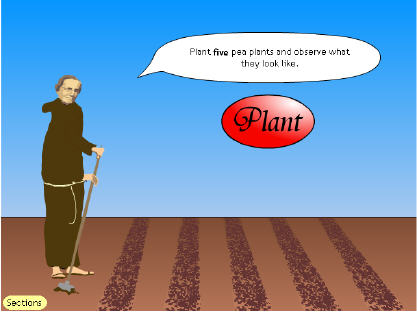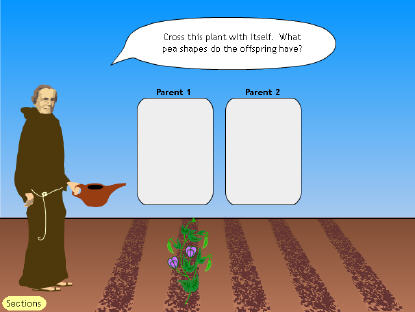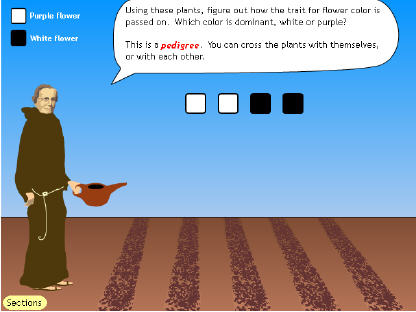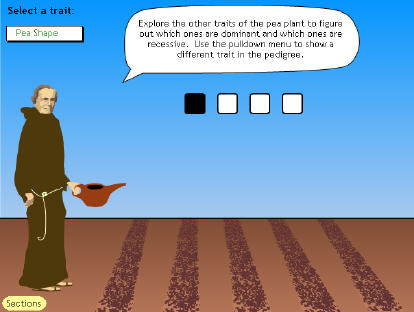The Web Lab
This web lab has five sections that are accessible through the “Sections” button in the lower left-hand corner of the screen. You can explore the entire web lab by clicking through or can jump to specific sections by using the menu. Each section is described below. Throughout the web lab you can roll your cursor over red italicized words to see their definitions. These definitions also appear in the glossary at the end of these instructions.
Introduction

Mendel is your guide throughout the web lab. When he first appears, he says, “Hello. My name is Gregor Mendel. I lived in Austria in the 1800s long before anyone knew about genes and genetics. I experimented with plants to study how traits are passed from parents to offspring ad discovered the basic rules of inheritance that are still used in your textbooks today. Come and try some of my experiments to see what you can discover about inheritance. Click Next to continue.” Click the red Next button in the lower right corner of the screen to continue.
The next text reads, “I used pea plants because they grow quickly and easily, and it is easy to see and recognize their different traits.” Click the red Next button in the lower right corner of the screen to continue.
Plant & Cross

This section of the web lab allows you to explore the traits on which Mendel experimented, then cross pea plants to see what offspring they produce.
Mendel says, “Plant five pea plants and observe what they look like.” Click the Plant button. The animated Mendel will plant and water five pea plants. You can observe the color of the pea pod, the shape of the pod, and the color and form of the ripe seed by rolling over the plants with your cursor.
Now, you can experiment with plant crosses. Using the five plants that you grew, cross any plant with itself or with another plant. After you have made five crosses, click the Next button to move on to the following section.
Predict Results

In this section of the web lab, you can explore plant crosses and predict what the offspring of these crosses will look like.
A plant with round peas and a random assortment of other traits appears on the screen. Mendel says “Cross this plant with itself. What pea shapes do the offspring have?” Drag the plant into one of the Parent boxes. Click the Cross button to cross the pea plant with itself and see five of its offspring.
Next a plant with wrinkled peas appears on the screen. Drag the plant into a Parent box and click the Cross button. Mendel appears and says, “What did you learn about your peas?”
When you click Next, two plants appear on the screen, both with wrinkled peas. Predict whether you think the offspring will have only wrinkle peas, only round peas, or a mixture of pea types. Drag each plant into a Parent box, then click the Cross button.
Pedigree

In this section of the web lab, you can experiment with pea plants to try to discover which alleles are dominant and which are recessive. You will be using a pedigree to explore each of the traits in the pea plants. A pedigree is a diagram of a family history used for tracing a trait through several generations. The black and white boxes in the middle of your screen represent pea plants. White boxes signify that a plant has one variation of the trait, while black boxes signify that a plant has the other variation.
Mendel says, “Using these plants, figure out how the trait for flower color is passed on. Which color is dominant, white or purple? This is a pedigree. You can cross plants with themselves or with each other.”
Click on one of the boxes to highlight it. You can click on a second plant to cross two plants or cross the plant you have selected with itself by clicking the Cross button. Cross as many or as few plants as you would like to try to determine which flower color is dominant and which is recessive.
Explore

In this section you can explore all seven of the pea traits that Mendel investigated. Four pea plants appear in the pedigree. You can select which trait to explore, by using the pulldown box in the upper left corner of the screen. When you have determined which alleles are dominant, record your choices in your notepad by clicking on the View Notepad button. When the notepad appears, select the traits that you believe are dominant and click on the Check button to check your answers.
Glossary
Axial
Flowers located near the middle of the plant.
Dominant
Traits that appear to mask (or hide) other traits.
Pedigree
A diagram of a family history used for tracing a trait through several generations.
Recessive
Traits that can be hidden in one generation and then appear in the next.
Terminal
Flowers located at the ends of the stems.
Trait
A distinguishing characteristic.
| Back to Web Lab Directory |